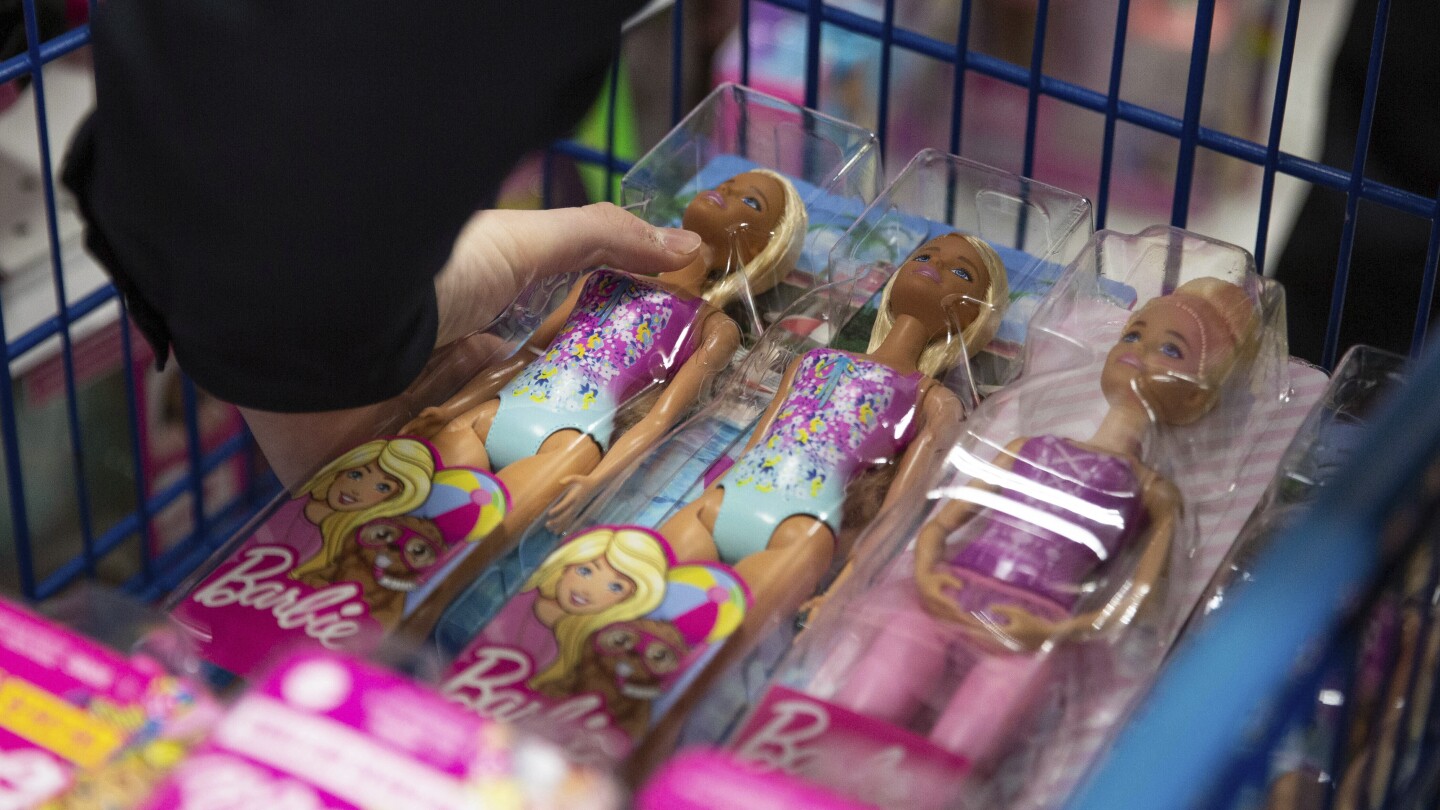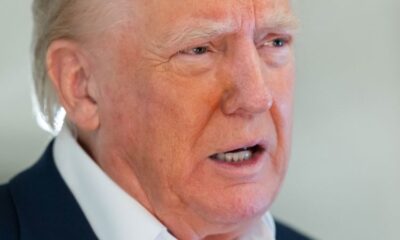Lifestyle
Kids author Mo Willems and The Pigeon stare down the future in a new book

NEW YORK (AP) — Author Mo Willems has sold millions of books and won many awards, but the accolade that means most to him is when a parent says their child read aloud for the first time from one of his books.
The author, illustrator and animator, 57, is best known for his bestselling picture books like the Caldecott Award-winning “Don’t Let the Pigeon Drive the Bus!” and “Knuffle Bunny.” His latest book, “Will the Pigeon Graduate?” may look like it’s aimed at children, but the titular Pigeon’s fear of failure and an uncertain future are sure to resonate with people of all ages, especially during graduation season.
Willems and his trusty friend The Pigeon (charmingly represented by puppeteer Bradley Freeman Jr.) recently sat down with The Associated Press for an interview about graduating, “Sesame Street,” and the purpose of life. Answers have been edited for clarity and brevity.
Children’s book author and illustrator Mo Willems has reunited with his old pal The Pigeon to promote their new book, “Will the Pigeon Graduate?” just in time for graduation season. Willems is known for his bestselling picture books “Don’t Let the Pigeon Drive the Bus!” and “Knuffle Bunny.” (May 9)
AP: How did graduation come to mind for a book topic?
WILLEMS: As I am getting older, which I am, I’m getting into a new part of my life. And I’m wondering, am I equipped to be living in this part of life? And as I ask that question and I don’t have the answers, then I think, well, what is that metaphor that kids are going through? And graduation seemed like the perfect thing. I’m graduating to a new stage in my life, and kids do this all the time. You graduate to tying your shoe. You graduate the first time you read.
THE PIGEON: Like driving a bus.
WILLEMS: Yeah, well, except for driving a bus. That is something you cannot graduate to, if you’re a pigeon, but thank you for contributing to the conversation.
THE PIGEON: Of course.
Mo Willems poses with The Pigeon, a character in his books, on April 22, 2025, in New York. (AP Photo/Gary Gerard Hamilton)
AP: People may think this is just for graduates, but could it be about any transition?
WILLEMS: I think it’s about asking yourself, “Am I equipped for something that scares me?” The real world is scary. We’re always asking ourselves those questions. And often the answer is … I don’t know. And that’s something that might feel uncomfortable to sit with, but it’s also something that’s very, very exciting. So like right now, I’m doing an interview with you and a giant pigeon. Is this gonna work out? If I’m going to get a little bit philosophical, I would say often we’re trying to give the answers, and I think kids get exhausted from it. I want to give them the questions. I want them to have a chance to live with these questions themselves and work their way into an answer rather than telling them, “Oh, you’ll be fine.”
AP: Mr. Pigeon, what is your favorite part about collaborating on this book?
THE PIGEON: I really like how all of the books are about me. I like how I’m on, like, almost every page. You know, all of these books go through an approval process, and I get sent advanced — I call them screeners, nobody likes when I call them that! — but I get to look at them. And if I’m not on the first page and the last page, it does not get approved.
AP (to Willems): Can you reflect on your nine seasons as a writer and animator on “Sesame Street,” winning six Emmys and helping to develop “Elmo’s World”?
WILLEMS: My love of puppets, my love of sketch comedy, my love of counting to 40 — all these things that I really, really love — came from “Sesame Street”! And when it came time for me to make books, one of the things that I got to do that we didn’t get to do on “Sesame Street” at the time was write about failure. Write about not driving the bus rather than driving the bus. So on one level, it was like going to grad school. I loved it. I learned so much. I met all of these great puppets and puppeteers. On the other, the restrictions of the show allowed me to find my own voice.
Mo Willems poses for a portrait on April 22, 2025, in New York. (AP Photo/Gary Gerard Hamilton)
AP: Obviously, one of the book’s messages is you have to believe in yourself.
WILLEMS: I don’t know. I’m glad that you think that that’s one of the messages because you brought something to that book. I only write 49% of the book. You put the meaning in the book; if the book is meaningful, that is because you are putting yourself within it. I try not to have messages as much as I can. I really try to live in the question.
AP: Mr. Pigeon, do you think your participation in this makes you a little bit of a philosopher?
THE PIGEON: Yeah, I think there’s a lot of very powerful things going on up here in this little bird brain. There’s a lot of really deep questions, like, I don’t know, can I drive the bus, maybe? You know, wondering maybe if I can stay up late? That would be really great.
WILLEMS: These are all fundamental Greek philosophical questions.
THE PIGEON: And what is the purpose of life?
WILLEMS: What is the purpose of life? Why are we here? Why are people mean? Why are people nice? Can I drive the bus?
THE PIGEON: Can I have a hot dog?
Lifestyle
Two dolls instead of 30? Toys become the latest symbol of Trump’s trade war

NEW YORK (AP) — President Donald Trump’s tariffs crusade has taken aim at a number of foreign goods, from European wines and car parts from Mexico to films made abroad. Lately, the president’s wandering ire has found another rhetorical poster child: toy dolls.
Trump asserted that children will be fine having two dolls — perhaps three or five — instead of 30 if U.S. import taxes increase consumer prices. The response on social media included memes of him portrayed as the Grinch and photos of a young Barron Trump’s child-sized Mercedes convertible.
“COMPLETELY out of touch,” The Loyal Subjects CEO Jonathan Cathey, whose collectible toy company in Los Angeles produces Strawberry Shortcake and Rainbow Brite dolls, wrote on Linkedin. “If that ain’t a ‘Let them eat cake’ moment shot through the echoes of history? Love how toys and dolls have become THE martyr metaphor for this nonsensical trade war incoherence.”
The president’s comments also touched a nerve with parents, both ones who took offense at the casual way he hypothesized that perhaps “two dolls will cost a couple bucks more” and those who acknowledged their own kids have more toys than they need.
Either way, the U.S. toy industry has a lot riding on a possible deescalation of the tariff standoff between the Trump administration and the government in Beijing. Nearly 80% of the toys sold in the U.S. come from China.
The Toy Association, a trade group, has lobbied for an immediate reprieve from the 145% tariff rate the president put on Chinese-made products. Some toy companies warn the likelihood of holiday shortages increases each week the tariff remains in effect.
Here’s a snapshot of the doll debate and how tariffs are impacting toys:
How much is the US doll market worth?
From Barbie, Bratz and Cabbage Patch Kids to Adora baby dolls, American Girl and Our Generation, dolls are a big business in the U.S. as well as beloved playthings.
The doll category, which includes accessories like clothes, generated U.S. sales of $2.7 billion last year compared to $2.9 billion in 2023 and $3.4 billion in 2019, according to market research firm Circana.
Consumers splurged on toys during the height of the COVID pandemic to keep children and themselves occupied, but sales flattened as inflation seized the economy.
Younger girls becoming more interested in buying makeup and skincare also has cooled the demand for dolls, Marshal Cohen, Circana’s chief retail advisor, said.
What are toy companies doing to navigate tariffs?
The nation’s largest toy maker, Mattel, said this week it would have to raise prices for some products sold in the U.S. to offset higher costs related to tariffs.
The company, whose brands include Barbie and American Girl, said the increases were necessary even though it’s speeding up the expansion of its manufacturing base outside of China.
Smaller toy companies are expected to have a harder time than Mattel and Hasbro, which makes the eating, drinking and diaper-wetting Baby Alive. Cathey said he paused The Loyal Subjects’ shipments from China in April because he couldn’t pay the stratospheric tariff they would have incurred.
“Nobody insulates themselves with that much cash,” he said.
With about four months’ worth of inventory on hand, Cathey said his ability to secure holiday stock depends on a break in the U.S.-China trade standoff happening in the next two weeks since it would take time for cargo operations to resume.
Cepia, a Missouri company that was behind the 2009 holiday season hit Zhu Zhu Pets, launched a line of 11-inch fashion dolls called Decora Girlz last year. CEO James Russell Hornsby said he was working to relocate some production but the move won’t happen in time to replace the orders he planned to get from China.
Hornsby described himself as a Trump supporter and said he understands the administration’s desire to reduce trade imbalances.
“Let’s just get the deals done and stop all this because (Trump’s) disrupting Christmas,” he said.
What goes into making a doll?
Although American Girl launched in 1986 with a line based on fictional historical characters, the dolls never were domestic products. They were made in Germany before production eventually moved to China.
Toy experts say that in addition to lower costs, Chinese factories have developed techniques and expertise that are not easily replicated.
“We don’t have any capacity in the U.S. to make rooted doll hair. And then you’ve got things like the faces. Some of them are hand-painted, others are done with a Tampo (printing) machine,” James Zahn, editor-in-chief of industry publication The Toy Book, said of doll-making.
Hornsby said rooting the synthetic hair onto the heads of Decora Girlz dolls is carried out by skilled workers at factories in Guangzhou and Dongguan, China.
“It’s not just sticking into a machine and it automatically does it,” he said. ”You have to know what you’re doing in order to make that doll look like it’s got a full set of hair when literally maybe only 60% of the head is filled with hair.”
Are toys from China safe?
White House Deputy Chief of Staff Stephen Miller said last week that he assumes consumers would prefer to pay more for American-made products. Dolls made in China might have lead paint in them, he said.
Teresa Murray, consumer watchdog director at the U.S. Public Interest Research Group, said the picture is more complicated.
Products for children ages 12 and under require third-party testing and certification from labs approved by the U.S. Consumer Product Safety Commission, the agency tasked with enforcing lead levels in toys, Murray said.
The rules apply to all products sold in the U.S. Toys by major brands such as Fisher-Price, Mattel, Hasbro and Lego, which have long outsourced manufacturing to China, are usually in compliance, she said.
But the rise of online shopping, including e-commerce platforms that ship directly to U.S. consumers from overseas, has posed a challenge, according to Murray. When valued at less than $800, such parcels entered the U.S. duty-free and were not subject to the same scrutiny as bulk imports, she said.
The White House eliminated the customs exemption starting May 2 for low-value parcels that originated in mainland China and Hong Kong. U.S Customs and Border Protection expects additional oversight will make it easier to flag problems.
Toy companies and industry experts argue the high tariffs on Chinese imports will tempt price-sensitive shoppers to search for cheap counterfeit toys that carry higher safety risks.
Can children have too many dolls?
Plenty of people agree American consumer culture has gotten out of hand, in large part due to prices kept low through the labor of foreign factory workers who earn much less than they would in the U.S.
Katie Walley-Wiegert, 38, a senior marketer in Richmond, Virginia, and the parent of a 2-year-old son, agrees there’s too much materialism but thinks parents should have choices when deciding what is best for their children. She found the wealthy Trump’s comments off-putting.
“I think it is a small view of what purchase habits and realities are for people who buy toys for kids,” Walley-Wiegert said.
San Francisco resident Elenor Mak, who founded the Jilly Bing doll company after she couldn’t find an Asian American doll for her daughter, Jillian, now 5, said the president’s remarks upset her because some families struggle to buy even one doll.
The trade war with China “just makes it even more impossible for those families,” Mak said.
Lifestyle
Indigenous fashion week in Santa Fe, New Mexico, explores heritage in silk and hides

SANTA FE, N.M. (AP) — Fashion designers from across North America are bringing inspiration from their Indigenous heritage, culture and everyday lives to three days of runway modeling starting Friday in a leading creative hub and marketplace for Indigenous art.
A fashion show affiliated with the century-old Santa Fe Indian Market is collaborating this year with a counterpart from Vancouver, Canada, in a spirit of Indigenous solidarity and artistic freedom. A second, independent runway show at a rail yard district in the city has nearly doubled the bustle of models, makeup and final fittings.
Three days of runway shows set to music will have models that include professionals and family, dancers and Indigenous celebrities from TV and the political sphere.
Clothing and accessories rely on materials ranging from of silk to animal hides, featuring traditional beadwork, ribbons and jewelry with some contemporary twists that include digitally rendered designs and urban Native American streetwear from Phoenix.
“Native fashion, it’s telling a story about our understanding of who we are individually and then within our communities,” said Taos Pueblo fashion designer Patricia Michaels, of “Project Runway” reality TV fame. “You’re getting designers from North America that are here to express a lot of what inspires them from their own heritage and culture.”
Santa Fe style
The stand-alone spring fashion week for Indigenous design is a recent outgrowth of haute couture at the summer Santa Fe Indian Market, where teeming crowds flock to outdoor displays by individual sculptors, potters, jewelers and painters.
Designer Sage Mountainflower remembers playing in the streets at Indian Market as a child in the 1980s while her artist parents sold paintings and beadwork. She forged a different career in environmental administration, but the world of high fashion called to her as she sewed tribal regalia for her children at home and, eventually, brought international recognition.
At age 50, Mountainflower on Friday is presenting her “Taandi” collection — the Tewa word for “Spring” — grounded in satin and chiffon fabric that includes embroidery patterns that invoke her personal and family heritage at the Ohkay Owingeh Pueblo in the Upper Rio Grande Valley.
“I pay attention to trends, but a lot of it’s just what I like,” said Mountainflower, who also traces her heritage to Taos Pueblo and the Navajo Nation. “This year it’s actually just looking at springtime and how it’s evolving. … It’s going to be a colorful collection.”
More than 20 designers are presenting at the invitation of the Southwestern Association for Indian Arts.
Fashion plays a prominent part in Santa Fe’s renowned arts ecosystem, with Native American vendors each day selling jewelry in the central plaza, while the Institute for American Indian Arts delivers fashion-related college degrees in May.
This week, a gala at the New Mexico governor’s mansion welcomed fashion designers to town, along with social mixers at local galleries and bookstores and plans for pop-up fashion stores to sell clothes fresh off the fashion runway.
International vision
A full-scale collaboration with Vancouver Indigenous Fashion Week is bringing a northern, First Nations flair to the gathering this year with many designers crossing into the U.S. from Canada.
Secwépemc artist and fashion designer Randi Nelson traveled to Santa Fe from the city of Whitehorse in the Canadian Yukon to present collections forged from fur and traditionally cured hides — she uses primarily elk and caribou. The leather is tanned by hand without chemicals using inherited techniques and tools.
“We’re all so different,” said Nelson, a member of the Bonaparte/St’uxwtéws First Nation who started her career in jewelry assembled from quills, shells and beads. “There’s not one pan-Indigenous theme or pan-Indigenous look. We’re all taking from our individual nations, our individual teachings, the things from our family, but then also recreating them in a new and modern way.”
Urban Indian couture
Phoenix-based jeweler and designer Jeremy Donavan Arviso said the runway shows in Santa Fe are attempting to break out of the strictly Southwest fashion mold and become a global venue for Native design and collaboration. A panel discussion Thursday dwelled on the threat of new tariffs and prices for fashion supplies — and tensions between disposable fast fashion and Indigenous ideals.
Arviso is bringing a street-smart aesthetic to two shows at the Southwestern Association for Indian Arts runway and a warehouse venue organized by Amber-Dawn Bear Robe, from the Siksika Nation.
“My work is definitely contemporary, I don’t choose a whole lot of ceremonial or ancestral practices in my work,” said Arviso, who is Diné, Hopi, Akimel O’odham and Tohono O’odham, and grew up in Phoenix. “I didn’t grow up like that. … I grew up on the streets.”
Arviso said his approach to fashion resembles music sampling by early rap musicians as he draws on themes from major fashion brands and elements of his own tribal cultures. He invited Toronto-based ballet dancer Madison Noon for a “beautiful and biting” performance to introduce his collection titled Vision Quest.
Santa Fe runway models will include former U.S. Interior Secretary Deb Haaland of Laguna Pueblo, adorned with clothing from Michaels and jewelry by Zuni Pueblo silversmith Veronica Poblano.
Lifestyle
Transgender troops being moved out of the military under new Pentagon order

WASHINGTON (AP) — The Pentagon will immediately begin moving as many as 1,000 openly identifying transgender service members out of the military and give others 30 days to self-identify under a new directive issued Thursday.
Buoyed by Tuesday’s Supreme Court decision allowing the Trump administration to enforce a ban on transgender individuals in the military, the Defense Department will begin going through medical records to identify others who haven’t come forward.
Defense Secretary Pete Hegseth, who issued the latest memo, made his views clear after the court’s decision.
“No More Trans @ DoD,” Hegseth wrote in a post on X. Earlier in the day, before the court acted, Hegseth said that his department is leaving wokeness and weakness behind.
“No more pronouns,” he told a special operations forces conference in Tampa. “No more dudes in dresses. We’re done with that s—.”
Department officials have said it’s difficult to determine exactly how many transgender service members there are, but medical records will show those who have been diagnosed with gender dysphoria, who show symptoms or are being treated.
Those troops would then be involuntarily forced out of the service. And no one with that diagnosis will be allowed to enlist. Gender dysphoria occurs when a person’s biological sex does not match up with their gender identity.
Officials have said that as of Dec. 9, 2024, there were 4,240 troops diagnosed with gender dysphoria in the active duty, National Guard and Reserve. But they acknowledge the number may be higher.
There are about 2.1 million total troops serving.
The memo released Thursday mirrors one sent out in February, but any action was stalled at that point by several lawsuits.
The Supreme Court ruled that the administration could enforce the ban on transgender people in the military, while other legal challenges proceed. The court’s three liberal justices said they would have kept the policy on hold.
Neither the justices in the majority or dissent explained their votes, which is not uncommon in emergency appeals.
When the initial Pentagon directive came out earlier this year, it gave service members 30 days to self-identify. Since then, about 1,000 have done so.
In a statement, Pentagon spokesman Sean Parnell said the 1,000 troops who already self-identified “will begin the voluntary separation process” from the military.
Under the new guidelines, active duty troops will have until June 6 to voluntarily identify themselves to the department, and troops in the National Guard and Reserve will have until July 7.
While it may be difficult to see which troops have changed their gender identity in their military records, it will be easier to determine who has gotten a gender dysphoria diagnosis because that will be part of their medical record, as will any medication they are taking.
Between 2015 and 2024, the total cost for psychotherapy, gender-affirming hormone therapy, gender-affirming surgery and other treatment for service members is about $52 million, according to a defense official, who spoke on condition of anonymity to discuss personnel issues.
Pentagon officials in an earlier memo defended the ban, saying that “the medical, surgical, and mental health constraints on individuals who have a current diagnosis or history of, or exhibit symptoms consistent with, gender dysphoria are incompatible with the high mental and physical standards necessary for military service.”
The new Pentagon policy would allow for limited exemptions.
That includes transgender personnel seeking to enlist who can prove on a case-by-case basis that they directly support warfighting activities, or if an existing service member diagnosed with gender dysphoria can prove they support a specific warfighting need, never transitioned to the gender they identify with and proves over 36 months they are stable in their biological sex “without clinically significant distress.”
If a waiver is issued, the applicant would still face a situation where only their biological sex was recognized for bathroom facilities, sleeping quarters and even in official recognition, such as being called “Sir” or “Ma’am.”
___
-

 Europe2 days ago
Europe2 days agoVance says Russia ‘asking for too much’ in concessions, while Trump says decisions ‘have to be made’ soon
-

 Middle East2 days ago
Middle East2 days agoThe Take: What does Israel’s escalation with the Houthis mean for Yemen? | Houthis News
-

 Conflict Zones2 days ago
Conflict Zones2 days ago‘Don’t want war’: Kashmiri towns caught in deadly India-Pakistan crossfire | India-Pakistan Tensions
-

 Africa1 day ago
Africa1 day agoAlgeria commemorates thousands killed by French troops in 1945 massacres
-

 Europe2 days ago
Europe2 days agoLive updates: Trump to make trade deal announcement with UK
-

 Middle East1 day ago
Middle East1 day agoKey takeaways: Documentary names alleged killer of Al Jazeera’s Abu Akleh | Crime News
-

 Europe2 days ago
Europe2 days agoUK’s King Charles lays wreath to mark 80th anniversary of VE Day
-

 Middle East1 day ago
Middle East1 day agoIsrael retrofitting DJI commercial drones to bomb and surveil Gaza | Israel-Palestine conflict News




